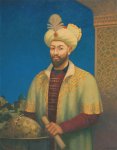 One of the streets of Almaty is named after Mirzo Ulugbek, which is located to the west of Altynsarin Street and to the north of Abay Avenue (previously named as Domostroitelnaya Street).
One of the streets of Almaty is named after Mirzo Ulugbek, which is located to the west of Altynsarin Street and to the north of Abay Avenue (previously named as Domostroitelnaya Street).
Mirzo Ulugbek (1394-1449)
Mirzo Muhammad Ibn Shahrukh Ibn Timur Ulugbek Guragan – the grandson of the great conqueror Tamerlane – was a ruler of Timurids’ Turkic state, an outstanding astronomer and astrologer. He was born on the 22nd of March, 1394 in Sultaniya city during five-year campaign of his grandfather Timur (Tamerlane).
Interesting facts about great astronomer’s life
According to legend, in childhood Ulugbek visited the ruins of famous Nasir al-Din al-Tusi observatory in Maraga. It impressed the curious boy so much, and triggered his ardour for astronomy.
In 1417-1420s Ulugbek built madrasah in the capital of his state – Samarkand, which initiated the building of Registan architectural complex. The other two madrasahs were built by him in Gijduvon and Bukhara. The portal of the latter still keeps the inscription (Hadis of prophet Mohammed): “Desire for knowledge is a must for each Muslim – man and woman”. (Generally, all numerous inscriptions on madrasah call people upon learning sciences).
Under Ulugbek Samarkand became one of the world’s science centers in the Middle Ages. There in the first half of the 15th century Ulugbek was one of the initiators of scientific school, which united prominent astronauts and mathematicians of Islamic world – Ghiyath al-Din Jamshid al-Kashi, Qazi Zada al-Rumi, Ali Qushchi.
Observatory built by Ulugbek was the place where Zij-i Sultani was made – the star catalogue which described 1018 stars, as well as the length of stellar sky: 365 days, 6 hours, 10 minutes and 8 seconds (the error was only +58 seconds in comparison with modern measurements!). Just imagine that this discovery was made in the times when there had been no telescope invented!
“New Guragan astronomic tables” have been rightly regarded as Ulugbek’s chief treatise. The author finished this work in 1444 after 30 years of painstaking job and astronomic observations. Astronomic manual was translated to Latin language and along with Claudius Ptolemy’s “Almagest” and astronomic tables of Castilian king Alfonso the 15th, was the handbook of astronomic science in all European observatories. The accuracy of these tables excelled all works that had been created before in the Orient and in Europe.
If Ulugbek’s personality hadn’t combined essential components of success, creation of Samarkand observatory wouldn’t have been possible. They represented the fact that he was a talented scientist, who was sensible in understanding scientific aim and ways of its realization, and a ruler of powerful state having enough money on his disposal.
Ulugbek was a great patron of science and arts. Besides astronomy and geography he was keen on poetry and history. He was the author of historical work “The history of four uluses”.
Since 1427 till 1447 Ulugbek was not conducting any significant military operations – quite the contrary, in 1428 he implemented important monetary reform, which became beneficial for the state’s economy.
After the defeat in Khorasan campaign in 1447 the conflict between Ulugbek and his elder brother arose, which later transformed into warfare. Ulugbek was defeated in that war. Soon after this Ulugbek was treacherously murdered.
His famous pupil, Samarkand astronomer Ali Qushchi escaped to Istanbul after Ulugbek’s death, where he gained the position of professor in madrasah Hagia Sophia.
Ulugbek’s observatory was gradually going to ruins and at the end of 17th century was pulled down until in 1908-1914 archeologist V.L.Vyatkin found location of observatory’s residuals and performed their excavations.
German astronomer and complier of the Moon’s maps Johann Heinrich von Mädler in 1830 named lunar crater after Ulugbek, which was plotted on his lunar map.
The most detailed analysis of Ulugbek’s star catalogue, based on examination of 8 manuscripts kept in the libraries of Great Britain, was published in the USA in 1917 by E.B. Noble called «Ulugh Beg’s Catalogue of Stars. Revised from all Persian Manuscripts Existing in Great Britain».
Some Ulugbek’s personal belongings are extant now, however they are scattered over different museums and private collections all over the world. His private chest is now stored in Istanbul museum of Topkapy. Ulugbek’s jade cup is presented in the collection of the British Museum. Ruby stone that once was purfling Ulugbek’s crown is stored within the private collection of Arab sheikh as-Sabakh.
The source of this article is the site:
http://hamrohonim.net/mirzo-ulugbek